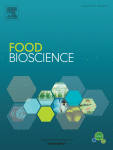Ver ítem
- xmlui.general.dspace_homeCentros Regionales y EEAsCentro Regional Buenos Aires NorteEEA San PedroArtículos científicosxmlui.ArtifactBrowser.ItemViewer.trail
- Inicio
- Centros Regionales y EEAs
- Centro Regional Buenos Aires Norte
- EEA San Pedro
- Artículos científicos
- Ver ítem
Overall evaluation of artichoke leftovers: Agricultural measurement and bioactive properties assessed after green and low-cost extraction methods
Resumen
Globe artichoke is rich in nutrients and phenolic compounds. However, nearly 85% of its biomass is discarded following harvest. To propose a scalable and economically attractive process for the revalorization of this material, a holistic analysis of the leftovers (bracts, stems and leaves) of three Argentine cultivars (Sampedrino, Gallego and Gringo) was proposed. Agricultural studies revealed differences for the crop yield of each variety and that bracts
[ver mas...]
Globe artichoke is rich in nutrients and phenolic compounds. However, nearly 85% of its biomass is discarded following harvest. To propose a scalable and economically attractive process for the revalorization of this material, a holistic analysis of the leftovers (bracts, stems and leaves) of three Argentine cultivars (Sampedrino, Gallego and Gringo) was proposed. Agricultural studies revealed differences for the crop yield of each variety and that bracts accounted for 65% of the overall waste biomass. Differences were also found for morphological features (aspect evaluation and color in the L*, a* and b* values). For the recovery of phenolic compounds, low-cost, green, and industrially applicable extraction methods were proposed and regardless of the water-based variations employed, stems extracts showed the highest values for biological activity. Among varieties, Sampedrino had the highest phenolic compounds concentration and antioxidant capacity for stems extracts (4.3 ± 0.2 mgGA/gFW for total phenolic compounds, 1.21 ± 0.01 mgGA/gFW for ABTS.+ scavenging capacity and 0.73 ± 0.02 mgGA/gFW for Ferric reducing antioxidant power). HPLC-MS confirmed the presence of 5-O-caffeoylquinic acid and dicaffeoylquinic acids in all samples, and a flavonoid with medical applications, kaempferol-3-O-glucoside, in leaves of all varieties. High concentrations of anthocyanins were also found in stems of all varieties. Here we propose friendly extractions using aqueous solvents for the recovery of health-promoting phenolic bioactive compounds that present great feasibility and transferability to the food industry for added-value products.
[Cerrar]

Autor
Zazzali, Ignacio;
Gabilondo, Julieta;
Peixoto Mallmann, Luana;
Rodrigues, Eliseu;
Perullini, Mercedes;
Santagapita, Patricio R.;
Fuente
Food Bioscience 41 : 100963 (June 2021)
Fecha
2021-06
Editorial
Elsevier
ISSN
2212-4292
Formato
pdf
Tipo de documento
artículo
Palabras Claves
Derechos de acceso
Restringido
 Excepto donde se diga explicitamente, este item se publica bajo la siguiente descripción: Creative Commons Attribution-NonCommercial-ShareAlike 2.5 Unported (CC BY-NC-SA 2.5)
Excepto donde se diga explicitamente, este item se publica bajo la siguiente descripción: Creative Commons Attribution-NonCommercial-ShareAlike 2.5 Unported (CC BY-NC-SA 2.5)

